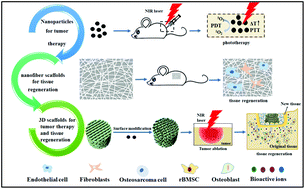Nanobiomaterials: from 0D to 3D for tumor therapy and tissue regeneration
Abstract
Nanobiomaterials have attracted tremendous attention in the biomedical field. Especially in the past few years, a large number of low dimensional nanobiomaterials, including 0D nanostructures, 1D nanotubes and 2D nanosheets, were employed for tumor therapy due to their optically triggered tumor therapy effects and drug loading capacities. However, these low dimensional nanobiomaterials cannot support cell adhesion and possess poor tissue regeneration ability, thus they are not suitable for application in regenerative medicine. Three dimensional (3D) nanofiber scaffolds have attracted extensive attention in tissue regeneration, including bone, skin, nerve and cardiac tissues, due to their similar extracellular matrix structures. Additionally, many 3D scaffolds displayed bone and cartilage regeneration abilities. Therefore, to obtain materials with both tumor therapy and tissue regeneration abilities, it is meaningful and necessary to develop 3D nanobiomaterials with multifunctions. In this review, we systematically review the research progress of nanobiomaterials with varied dimensional structures including 0D, 1D, 2D and 3D, as well as evolutional functions from single tumor therapy to simultaneous tumor therapy and tissue regeneration. This review may pave the way for developing an interdisciplinary research of nanobiomaterials in combination of tumor therapy and regenerative medicine.

- This article is part of the themed collection: Recent Review Articles


 Please wait while we load your content...
Please wait while we load your content...